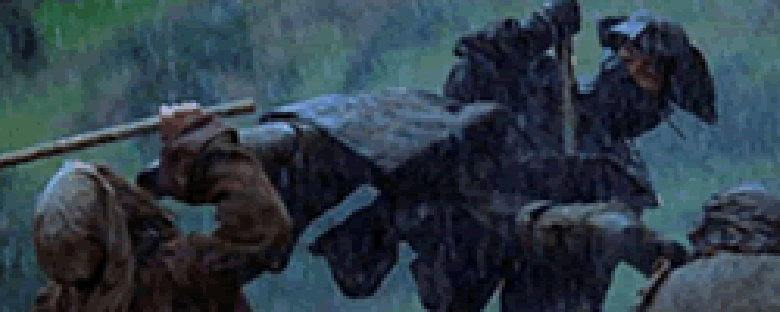Reviews
Le Pacte des Loups
Christophe Gans
France, 2001
Credits
Review by Rumsey Taylor
Posted on 10 July 2004
Source Universal Studios DVD
Violating the characteristics of most all prior French films is Brotherhood of the Wolf. It may be overlong, although it is not pretentious, not pensive by even the most generic standard, and it does not subscribe to any real issues. (Talk of the “Reign of Terror,” although apparent in the film, is kept to a minimum.)
Brotherhood’s staple description cites its reckless inclusion of different — if not contradictive — filmic conventions. To illustrate, imagine a period costume drama (Dangerous Liaisons) edited with the sporadic frenzy and movement of a fight scene in a John Woo film (The Killer) — the two simply do not work together, and these are but two of the film’s many indebted styles. Curiously, the film honors its every element, from the breadth and variety of its design to the careful revelation of the Bad Guy. Brotherhood of the Wolf is a unique vision comprised of borrowed set pieces, and its visible, bursting seams enhance its goofy appeal.
(And it is based on a true story.)
The film opens with the “Beast of Gevaudan” accumulating a number of female victims in southern France in 1764. Fronsac, an artist and skeptic, and Mani, a mysteriously silent Indian, are recruited to study and hunt it. There is also a bordello inhabited by a supposed witch, a suspicious member of the aristocracy who engraves his initial in his bullets, and an underground cult that may or may not be connected with the beast. This synopsis is deceivingly simple, as Brotherhood (at over two hours) spends time developing each plot point — some relatively engaging, some out of place, others ridiculous. Once its direction (or purposed lack of) becomes affirmed, the film becomes exceedingly entertaining, as overall coherence is sacrificed in favor of many scenes’ individual successes — and there are many.
Borrowing liberally from Jaws, the bulk of the film is concerned with locating the beast. At first it only exists in evidence of attacks (the opening kill, although on land, closely mirrors the corresponding death in Jaws). A mangled corpse is found; it is a naked female victim, establishing — intended or not — the sexist masochism identified in slasher films. (The unseen beast is so menacing that its legend frightens men although it only victimizes women.) Fronsac quickly evaluates the damage and guesses the size of the beast’s jaw. Without citing the measure, particularly, it can be assumed that it is a frightening length.
Brotherhood of the Wolf sacrifices its more political elements in favor of the beast’s hunt. (A love triangle, for one, lacks resolution.) Had the film time to further establish many themes contained in its wide embrace, Brotherhood may have been more legitimate.
Brotherhood of the Wolf is not merely flawed but sporadic to the point of being ridiculous — but that’s the point. It supplies enough to satisfy many tastes without overwhelming them. It is one of the most sporadically inspired films of recent memory; and I would say, prematurely, of all time.
We don’t do comments anymore, but you may contact us here or find us on Twitter or Facebook.



